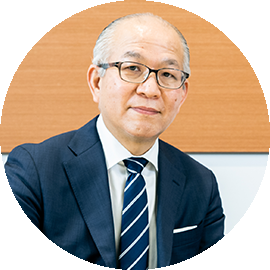The use of hydrogen is being explored around the world. Hydrogen, along with electricity, is a high-potential energy carrier which will contribute toward achieving carbon neutrality. Two leaders who will play key roles in upcoming major moves in Honda’s hydrogen business discuss why hydrogen is so important, and how Honda will utilize it.

Head of Business Development Supervisory Unit, Business Development Operations View More Close Arata Ichinose
Read More
General Manager of Hydrogen Business Development Division, Business Development Supervisory Unit, Business Development Operations View More Close Tetsuya Hasebe
Read MoreHonda plans to launch the next-generation FCEV model. Why hydrogen now?
Hydrogen is expected to have high potential as a clean energy carrier. Why is hydrogen important?
 Ichinose describes the importance of hydrogen.
Ichinose describes the importance of hydrogen.

The hydrogen cycle begins with renewable energy and consists of three phases – generate, store/transport and use. Electricity derived from renewable energy can be converted into “green hydrogen*” using water electrolysis technology. By utilizing this hydrogen, electricity can be stored as hydrogen, and at the same time, be transported by land and sea, and pipeline. By utilizing fuel cell systems, environmentally-responsible electricity can be produced without CO2 emissions.
*Hydrogen generated through electrolysis of water using electricity derived from renewable energy sources
 Unique characteristics and advantages of hydrogen
Unique characteristics and advantages of hydrogen
Hydrogen has many advantages. How has Honda been approaching hydrogen?

Honda has long been conducting research and development of fuel cells, which generate electricity from hydrogen and oxygen. We began working on the application of fuel cells to passenger vehicles, ahead of other automakers, in the second half of the 1990s, and in 2002 we launched the world’s first FCEV, simultaneously in Japan and the U.S. In 2008, we launched the FCX Clarity sedan. Then, we further downsized our fuel cells, and in 2016, we introduced the Clarity Fuel Cell, which became the world's first FCEV that realized 5-seat packaging. Next year, in 2024, we plan to launch an all-new FCEV based on the CR-V 5-seater SUV.
 Honda’s FCEV history
Honda’s FCEV history

My first encounter with an FCEV was when I saw a prototype based on the first-generation Odyssey, which only had first row seats and the rest of the vehicle was filled with the required fuel cell units. I was amazed and thought it looked like a small-scale power plant.
With the Clarity Fuel Cell, as a function leader, I was in charge of developing power electronics and control system components. We had to comply with tough requirements for high output and compact size, and we also took on technological challenges nobody in the world had done before. Although we struggled with the high level of technical difficulty, I feel that it was a very good experience for Honda.
 Hasebe was involved in Clarity Fuel Cell development
Hasebe was involved in Clarity Fuel Cell development
Expanding Honda business into four domains of hydrogen utilization
How will Honda expand applications of its fuel cells in the future?

Honda has been elevating the performance of its fuel cell systems by solving issues one by one, such as downsizing, cost reduction and improving durability. Through the co-development with General Motors (GM), which started in 2013, we have further reduced the cost and increased durability and low-temperature resistance. And now, in addition to applying to our passenger vehicles, we will begin external sales of this next-generation fuel cell system to expand the field where our technology can be utilized.
 Next-generation fuel cell system
Next-generation fuel cell system

Hydrogen has some unique characteristics such as higher energy density compared to a battery, with high transportability and a short time to fill the tank. This makes hydrogen suitable as a power source for large-size mobility products that are heavily used, mobility products that require quick energy refueling and large-scale infrastructure, which are considered difficult to be powered by batteries.

Honda is striving to realize a carbon-neutral society by utilizing its fuel cell systems, the core of Honda hydrogen technology. To this end, we would like to expand the circle of hydrogen utilization as fast as we can. To achieve this goal, we have identified four core domains we will focus on during the early phase of our hydrogen business: Honda FCEV models, commercial vehicles, stationary power stations and construction machinery.
 Newly identified four core domains
Newly identified four core domains
Honda will take on new challenges in the domains of commercial vehicles, stationary power stations and construction machinery. Why these three?

Commercial vehicles are heavier and have longer range than passenger vehicles and, therefore, benefit significantly from the utilization of hydrogen energy. By combining multiple units of our fuel cell system, the high output required by commercial trucks can be achieved.
We have already begun multiple joint research projects on commercial fuel cell trucks. With Isuzu Motors, we completed a prototype of a fuel cell-powered heavy-duty truck in 2021, and we are planning to begin demonstration testing on public roads before the end of the upcoming fiscal year ending March 31, 2024 (FY2024). Furthermore, in China, which has one of the largest commercial vehicle markets in the world, we have begun performance verification of medium-duty fuel cell truck jointly with Dongfeng Motor Group.


Aside from mobility products, we are also taking on challenges in the area of power generation, to make clean stationary power stations (power generators installed in factories and other commercial facilities). Stationary power stations are usually used for peak shaving or as a regulating power source; however, they are also required to operate continuously for 48 hours or more as a backup power source in case of a disaster. This is where the value of hydrogen, which can store energy at high density, comes into play.
We have just installed a stationary fuel cell power station on the corporate campus of American Honda and will begin in-house demonstration operation as a backup power source for a data center. Although performance verification has yet to be conducted, we have confirmed that the station, which reuses and combines multiple fuel cell units from Honda Clarity Fuel Cell vehicles, generates electricity without any problem. From here onward, we would like to build a track record of installing stationary fuel cell power stations to our own facilities, so we can deliver our fuel cell power station technology to customers as soon as possible.
 Honda will begin stationary power station testing internally in the U.S.
Honda will begin stationary power station testing internally in the U.S.

Construction machinery, which is heavy and operates for long hours, is another area where hydrogen energy utilization is expected. In the construction machinery market, many excavators and wheel loaders are powered by diesel engines, and if we can begin converting them to become hydrogen-powered, we can make a greater contribution to carbon neutrality.

In addition to the contribution to carbon neutrality, being a zero-emission power unit is an important feature of fuel cells. Also, fuel cell systems make less vibration and noise than diesel engines. These features enable fuel cell-powered commercial trucks and construction machinery to be quieter, reduce driver/user fatigue, enhance safety at work sites and reduce the burden on people who are in the vicinity. Technology helps people, and Honda takes this very seriously.

We are looking into outer space as a future field where hydrogen technologies can play an important role. We have been commissioned by the Japan Aerospace Exploration Agency (JAXA) to conduct research and development of a “circulative renewable energy system” that combines our fuel cell system and high differential pressure water electrolysis system to supply electricity to the living space of a lunar rover. We hope to hone our technology in the harsh environment of outer space, and further expand our field of contribution back on Earth.
Realizing carbon neutrality by connecting hydrogen use across various domains
How will Honda's hydrogen business evolve in the future, with an emphasis on collaboration with other companies?

There are two directions of collaboration. One is to collaborate with manufacturers that produce and sell original equipment such as commercial vehicles and construction machienry, which we view as a "point" strategy. The other is collaboration to form hydrogen ecosystems and create an economic zone. We see this as a "surface" strategy.
Our collaboration with OEMs of commercial trucks is an easy example of the “point” strategy. As to “surface” strategy, we will pursue collaboration which evolves around stationary power stations and hydrogen supply, targeting businesses and facilities which are expected to have major demand for hydrogen such as data centers, factories and ports. By combining various batteries and hydrogen-powered mobility products, we will strive to realize hydrogen ecosystems unique to Honda, which accommodate the needs of society. To this end, we will accelerate collaboration and partnering in this area.
 Honda’s vision of contributing to the hydrogen cycle
Honda’s vision of contributing to the hydrogen cycle
Tell us about your passions toward the realization of carbon neutrality which we see beyond the popularization of hydrogen use?

In the future society, to which we are heading, we believe it is necessary to efficiently use a variety of energy sources available in each region, and advance our mobility and daily lives. It is not a choice between electricity or hydrogen. It is important for us to understand the unique characteristics of both and utilize the right energy in the right places and for the right purposes.
Our environmental target of "realizing carbon neutrality for all products and corporate activities Honda is involved by 2050" is not something we can accomplish easily. To achieve this target, we need to contribute to the optimization of total energy consumption and energy efficiency for the entire society by taking into account the diversity of mobility products, the various ways and living environments in which people use mobility products and the availability of renewable energy in each area.
 Honda aims to realize the “hydrogen cycle” where Honda connects various players
Honda aims to realize the “hydrogen cycle” where Honda connects various players

There is no end to the challenges we need to take on, such as increasing the competitiveness of our fuel cell technologies and building partnerships to work toward the realization of a hydrogen ecosystem. Beyond these challenges, we will become able to offer even greater value to our customers and society by offering various Honda products which are linked to each other and connected across various domains. For the realization of carbon neutrality, along with our EV and fuel cell businesses, we would like to create new businesses that will enable Honda to provide a new value of mobility.
Original article issued on February 2, 2023






Hydrogen is expected to be used in combination with power generation from renewable energy sources, which is indispensable for achieving carbon neutrality. Power generation from renewable energy sources such as solar and wind power is more susceptible to seasonality and weather conditions and therefore unstable. To ensure stable use of renewable energy, we need a means to store electricity that absorbs the impact of fluctuations in power generation. This is where hydrogen shows high potential as an energy carrier.